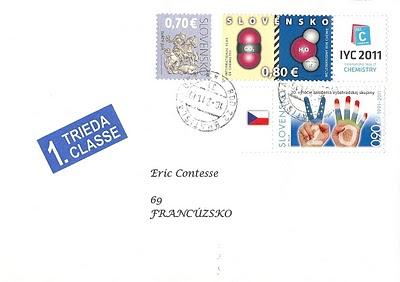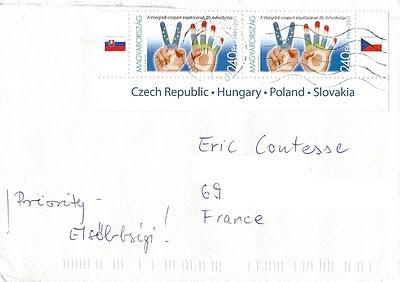A l'initiative de la Slovaquie, qui préside actuellement cette organisation informelle (jusqu'en juin 2011), les administrations postales des 4 pays (Hongrie, République Tchèque, Slovaquie, Pologne) faisant partie de ce Groupe de Visegrád ont émis, le 11 février 2011, un timbre commun pour commémorer le 20ème anniversaire de sa création.
J'ai eu la grande chance de recevoir les lettres ci-dessous en provenance de ces 4 pays, affranchies chacune avec ce timbre commun !!!
La version de la poste slovaque (0,90€) figure sur la 1ère lettre ci-dessous postée le 16 février 2011 de Bratislava. Merci beaucoup Robert :-)
On the initiative of Slovakia, currently chairing this informal organization (until June 2011), the postal administrations of the four countries (Hungary, Czech Republic, Slovakia, Poland), part of the Visegrad Group have issued, on February 11, 2011, a joint stamp to commemorate the 20th anniversary of its establishment.
I was very lucky to receive the covers below from these four countries, each franked with this joint stamp !!!
The version of the Slovak Post (€ 0.90) appears on the first letter below mailed on February 16, 2011 in Bratislava. Thank you very much Robert :-)

Robert a complété son affranchissement ci-dessus avec les 2 premiers timbres émis par la poste slovaque en 2011. Celui à 0,80€, émis le 17 janvier 2011, évoque l'année internationale de la chimie 2011 (AIC 2011) avec ces 2 molécules d'eau et de dioxyde de carbone qui interagissent dans le processus de la photosynthèse. A noter la vignette attenante reproduisant le logo officiel de cette AIC 2011.
Le dernier timbre (0,70€), émis le 28 janvier 2011, complète cette splendide série courante consacrée à l'art religieux. Un détail du maître-autel gothique en pierre de l'église Saint-Georges de Svätý Jur (proche de Bratislava) y est représenté (Saint-Georges terrassant le dragon).
I will speak about the illustration of this joint stamp further down on this post.
Robert has completed his postage above with the first two stamps issued by the Slovak Post in 2011. The € 0.80 stamp, issued on January 17, 2011, is devoted to the 2011 International Year of Chemistry (IYC 2011) with these two molecules of water and carbon dioxide interacting in the process of photosynthesis. To note the attached coupon reproducing the official logo of this IYC 2011.
The last stamp (€ 0.70), issued on January 28, 2011, completes this splendid definitive series devoted to religious art. A detail of the stone high altar of the Gothic Church of St. George at Svätý Jur (near Bratislava) is featured here (St. George slaying the dragon).

Un aperçu ci-dessus avec la bande inférieure de cette feuille, émise par la poste hongroise. Merci beaucoup Bertalan pour cette lettre postée le 28 février 2011 de la ville d'Esztergom :-)
But let's speak now about this joint issue. The postal administrations of the four countries have all issued this stamp in a sheet of 8 stamps (4 horizontal bands of 2 stamps) with the words "20 Years of the Visegrad Group", in the language of the country, in the top margin and the names of the four countries (in English !) in the bottom margin. The flags of the four countries are also included in the two vertical margins on the right and left.
Here is above the lower band of this sheet issued by the Hungarian Post. Thank you very much Bertalan for this letter mailed on February 28, 2011 from the city of Esztergom :-)
Merci beaucoup Milan :-)
Ce Groupe de Visegrád a donc été créé en 1991 lors d'un sommet de chefs d'état de Tchécoslovaquie, de Pologne et de Hongrie organisé dans la ville hongroise de Visegrád. Le but de cette organisation informelle était alors de mettre en place des coopérations entre ces 3 pays (qui deviendront 4 en 1993 après la partition de la Tchécoslovaquie) afin d'accélérer le processus d'intégration européenne puis plus tard l'intégration à l'Otan.
The Czech version of this stamp (with the Czech flag in the margin !) appears on the other cover above mailed on March 7, 2011 from the town of Kroměříž.
Thank you very much Milan :-)
This Visegrad Group was therefore established in 1991 during a summit of heads of state of Czechoslovakia, Poland and Hungary held in the Hungarian town of Visegrad. The purpose of this informal organization was then to develop cooperation between these three countries (which became four in 1993 after the partition of Czechoslovakia) to accelerate the process of European integration and later integration into NATO.
Le timbre à date "1er jour" est également conçu à partir des positions géographiques respectives de ces 4 capitales.
Merci beaucoup Kazimierz :-)
Here is above the stamp issued by the Polish Post, on this interesting official FDC with the map of Europe to the left allowing to locate (red dots) the respective capitals of the four countries (Budapest, Bratislava, Prague and Warsaw from south to north).
The FDC postmark is also designed from the respective geographic locations of these four capitals.
Thank you very much Kazimierz :-)
Les 2 timbres en haut composent la 1ère bande de la feuille de 8 timbres avec la mention "20. Rocznica Utworzenia Grupy Wyszehradzkiej" dans la marge supérieure.
Ce Groupe de Visegrád est aussi appelé Visegrád 4 ou V4, ce que le graphiste hongrois Barnabás Baticz a symbolisé sur ce timbre via ces 2 mains.
L'union européenne est évoquée sur la main gauche et les différentes couleurs présentes sur les 4 drapeaux figurent sur les 4 doigts de la main droite. Le nombre "20" est également inscrit sur les 2 paumes.
Kazimierz was kind enough to send me also, on February 24, 2011, the four other envelopes above each stamped with this same joint stamp with the four different flags attached !
The two stamps at the top form the first band of the sheet of 8 stamps including the words "20. Rocznica Utworzenia Grupy Wyszehradzkiej" in the top margin.
This Visegrad Group is also called Visegrád 4 or V4, what the Hungarian designer Barnabás Baticz has symbolized on this stamp via these two hands.
The European Union is evoked on the left hand and the different colors on the four member countries' flags are depicted on the 4 fingers of the right hand. The number "20" is also included on the two palms.


